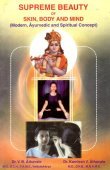Nashini, Nāśinī: 3 definitions
Introduction:
Nashini means something in Buddhism, Pali, Hinduism, Sanskrit. If you want to know the exact meaning, history, etymology or English translation of this term then check out the descriptions on this page. Add your comment or reference to a book if you want to contribute to this summary article.
The Sanskrit term Nāśinī can be transliterated into English as Nasini or Nashini, using the IAST transliteration scheme (?).
In Hinduism
Purana and Itihasa (epic history)
Source: archive.org: Shiva Purana - English TranslationNāśinī (नाशिनी) (Cf. Nāśin) refers to “she who destroys”, according to the Śivapurāṇa 2.3.12.—Accordingly, as Śiva said to Himācala (i.e., Himālaya): “[...] A woman is a phase of illusion. As the scholars who have mastered the Vedas say particularly, a young damsel is a hindrance to ascetics. [...] O mountain, by contact with a woman, worldliness springs up; non-attachment perishes and the virtuous penance is destroyed. Hence, O mountain, no ascetic shall have any truck with women. A woman is the root of all worldly attachments. She destroys all wisdom and detachment together [i.e., jñāna-vairāgya-nāśinī]”.

The Purana (पुराण, purāṇas) refers to Sanskrit literature preserving ancient India’s vast cultural history, including historical legends, religious ceremonies, various arts and sciences. The eighteen mahapuranas total over 400,000 shlokas (metrical couplets) and date to at least several centuries BCE.
Ayurveda (science of life)
Toxicology (Study and Treatment of poison)
Source: Shodhganga: Kasyapa Samhita—Text on Visha ChikitsaNāśinī (नाशिनी) refers to “that which extirpates” (poison), according to the Kāśyapa Saṃhitā: an ancient Sanskrit text from the Pāñcarātra tradition dealing with both Tantra and Viṣacikitsā—an important topic from Āyurveda which deals with the study of Toxicology (Viṣavidyā or Sarpavidyā).—Kāśyapa has recommended a slew of generic formulae that successfully neutralise rat poison.—According to Kāśyapasaṃhitā (verse 11.46cd-47): “Mustā, dipped in honey or ghee, also extirpates rat poison (viṣa-nāśinī). Unhusked, powdered sesame dipped in salt-water must be eaten with ginger and jaggery”.

Āyurveda (आयुर्वेद, ayurveda) is a branch of Indian science dealing with medicine, herbalism, taxology, anatomy, surgery, alchemy and related topics. Traditional practice of Āyurveda in ancient India dates back to at least the first millenium BC. Literature is commonly written in Sanskrit using various poetic metres.
In Buddhism
Tibetan Buddhism (Vajrayana or tantric Buddhism)
Source: Brill: Śaivism and the Tantric Traditions (tantric Buddhism)Nāśinī (नाशिनी) (Cf. Nāśin) refers to “dispelling (all opposed opinions)”, according to Vāgīśvarakīrti’s Tattvaratnāvalokavivaraṇa.—Accordingly, “This is the work to dispel all opposed opinions (vimati-nāśinī) of Vāgīśvara [Vāgīśvarakīrti], whose dedication to the glorious Samāja [Guhyasamāja] is supreme and whose devotion) is without blemish”.

Tibetan Buddhism includes schools such as Nyingma, Kadampa, Kagyu and Gelug. Their primary canon of literature is divided in two broad categories: The Kangyur, which consists of Buddha’s words, and the Tengyur, which includes commentaries from various sources. Esotericism and tantra techniques (vajrayāna) are collected indepently.
See also (Relevant definitions)
Ends with (+19): Aghavinashini, Aranyanashini, Bhavanashini, Bhayanashini, Bhuta nashini, Bhutanashini, Dadrunashini, Dakshayajnavinashini, Damshanashini, Dardrunashini, Dhvankshanashini, Duhkhavinashini, Durgatinashini, Dushtanashini, Jatharakriminashini, Jnananashini, Jvaranashini, Kalinashini, Kalivinashini, Kasanashini.
Full-text (+4): Kasanashini, Bhavanashini, Durgatinashini, Kshayanashini, Kushthanashini, Nashin, Bhuta nashini, Durgati, Dushtanashini, Kriminashini, Vishanashin, Jvaranashini, Kshiranacini, Bhayanashini, Shulanashini, Vishanashini, Dadrunashini, Damshanashini, Vimati, Papanashana.
Relevant text
Search found 5 books and stories containing Nashini, Nāśinī, Nasini; (plurals include: Nashinis, Nāśinīs, Nasinis). You can also click to the full overview containing English textual excerpts. Below are direct links for the most relevant articles:
Garga Samhita (English) (by Danavir Goswami)
Verse 3.10.2 < [Chapter 10 - The Glory of Śrī Girirāja]
Verse 3.7.7 < [Chapter 7 - The Holy Places of Śrī Girirāja]
Verse 3.4.15 < [Chapter 4 - The Coronation-Bathing of Śrī Kṛṣṇa]
A Manual of Khshnoom (by Phiroz Nasarvanji Tavaria)
Appendix III < [Appendices]
The Devi Bhagavata Purana (by Swami Vijñanananda)
The Skanda Purana (by G. V. Tagare)
Chapter 29 - Gaṅgā-Sahasranāma (A Thousand Names of Gaṅgā) < [Section 1 - Pūrvārdha]
Related products
